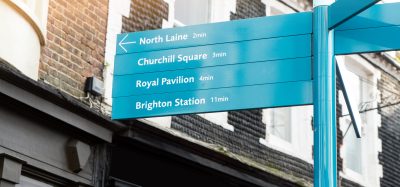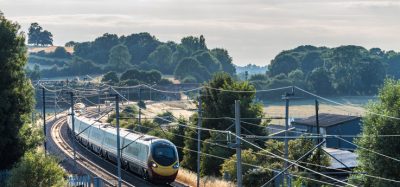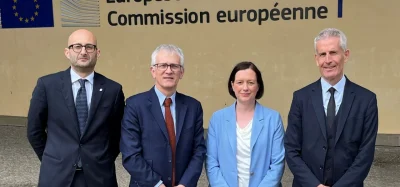The need for speed
Posted: 28 November 2006 | | No comments yet
The Italian transport system is strongly unbalanced in favour of the road and motorway network. Giovanni Costa, Responsible for the High-Speed/High-Capacity Net Project of the Financial Division of RFI, explained to the Global Railway Review that the constant growing demand for the movement of persons and freight is fulfilled increasingly by private transport.
The Italian transport system is strongly unbalanced in favour of the road and motorway network. Giovanni Costa, Responsible for the High-Speed/High-Capacity Net Project of the Financial Division of RFI, explained to the Global Railway Review that the constant growing demand for the movement of persons and freight is fulfilled increasingly by private transport.
The Italian transport system is strongly unbalanced in favour of the road and motorway network. Giovanni Costa, Responsible for the High-Speed/High-Capacity Net Project of the Financial Division of RFI, explained to the Global Railway Review that the constant growing demand for the movement of persons and freight is fulfilled increasingly by private transport.
The environmental, social and economic costs of this imbalance are obvious: traffic, pollution, a high accident rate and penalisation of the production and distribution system.
According to the data of Ministero delle Infrastrutture e dei Trasporti in 2003-2004, just 5.9% of passengers and 16.5% of freight are transported by rail, compared to 93% and 64% respectively by road. This situation can punish Italy in terms of both internal resources and its relationship with other European countries, which are increasingly inclined to limit road transit of heavy vehicles and to promote rail transport. Upgrading and improving the available railway service is therefore an essential objective for redressing this situation.
Closely integrated with existing lines, the High-Speed (HS)/High-Capacity (HC) lines will transform the Italian railway network into a HS/HC network and will stimulate and support the demand for freight traffic that is expected in the coming years and key to domestic economic development, and will make possible the complete reorganisation of urban railway hubs.
The Italian HS/HC system will extend for over 1,250km (including interconnections) along Italy’s busiest railway axes: the Turin-Venice line across Italy, and the Milan-Naples line down its backbone, with a branch to the port of Genoa. It will also affect more than 1,580km of tracks linking up with northern Europe through the Alpine transit tunnels, and with the South of Italy, to Naples, Bari and Reggio Calabria, down to Palermo.
The Italian HS/HC system will be fully operational between Turin, Milan and Naples in 2009, and will develop further in three subsequent stages: the first stage the new stations of Bologna and Florence (2010-2013), the second stage Milan-Verona-Padua-Venice, and the third stage continuation to the East, Alpine transit tunnels and the South.
The lines Turin-Milan-Naples, Milan-Verona-Padua and Terzo Valico, including the section crossing of Bologna, Rome and Naples urban junctions, are realized by RFI SpA (Rete Ferroviaria Italiana), through its company TAV. The works for the Turin, Milan and Florence urbanjunctions, the new station Rome Tiburtina and the upgrading to the new standards of Direttissima Rome-Florence, in operation since the 80s, are realized by RFI.
All activities integrate each other in the total development and modernisation program of Italian railways infrastructure realized by RFI.
Towards a high-capacity rail system
The new lines will be used for long-distance transportation of both passengers and freight and will upgrade the Italian rail system as a whole by transforming it into a high-capacity system with direct access to the main transport and interchange systems. The construction standards adopted, the geometrical parameters of the route, the maximum loads and the profile limitations, are such that will make the new infrastructure available to various kinds of trains and to guarantee interoperability with the European high-speed rail network and with existing national lines.
The interchange between these and the new lines is made possible by the interconnections. These will not only guarantee direct, rapid connections between large terminals, but will also extend the area of potential use of the high-speed lines to medium-sized cities not directly served by the new lines and create more efficient connections with the major logistic terminals.
The stations that are destined to receive the trains traveling on the new lines will be remodeled according to their new service requirements and, in some cases, be integrated with totally new High-Speed Railway stations constructed by RFI. Special stations for the high-speed trains will be built at Florence Belfiore, Rome Tiburtina, Turin Porta Susa, Milan Rho Fiera, Naples-Afragola, Bologna, and Reggio Emilia.
Technical characteristics
The new high-speed lines are constructed in accordance with the most advanced technological standards in order to ensure the maximum performance in terms of safety, speed, interchange with the existing lines and with the European high-speed lines for both passenger and freight transport. ERTMS: the new traffic control and management system
Italy will be the first country in Europe to adopt ERTMS (European Railway Management System) on the new lines, the new train control and distancing system developed at a European level to guarantee railway interoperability, i.e. the possibility of running trains belonging to transport operators of different nationalities on the new lines in order to increase the competitiveness of the service provided and at the same time guaranteeing the highest levels of safety. The new standard will harmonise the messages and means used for the exchange of signalling information between ground systems and trains and which currently differ from one country to another.
The ERTMS developed in Italy will use the GSM Railway system for ground-train dialogue (a system based on the now well-established mobile telephone technology), whereby the signals transmitted from the ground – under the driver’s supervision – are received directly by the on-board equipment and converted into travelling, spacing and braking instructions. The system has a central device (Radio Block Centre) that continuously transmits by radio to each train the speed to be observed on the basis both of the progress of other trains and of the constraints imposed by the track or other possible factors causing temporary speed reductions. At the same time, the train sends its position to the Centre.
On the Italian high-speed lines, the signalling systems installed along the tracks in conjunction with the on-board equipment (which includes conventional devices to allow the train also to travel on existing lines) enable the movement of the train to be monitored constantly and the brakes to be engaged automatically – solely to stop the train prior to a hazard in the event of an incorrect operation by the driver (ATC system).
Electric power supply
The single-phase 25kV AC 50Hz electrification system has been adopted on the high-speed Milan-Naples line, which is an innovation compared to the 3kV DC system used for electrification of the entire Italian railway system. A 3kV supply voltage is used at interconnections and urban junctions.
Current and future rail capacity
The main objective of the new railway infrastructure is to increase the capacity, efficiency and safety of the railway system along the country’s most intensely used and saturated routes. The new lines, along with separation of traffic types and the new signalling and safety systems, will considerably increase the overall capacity of the railway.
Journey times
Use of the most advanced technologies in existence and adoption of the best safety standards for trains and tracks, together with the specific characteristics of the routes, will allow the high-speed trains to run with shorter journey times between the various cities served by the new lines and in general between the different centres served by the railway network.
Investment and Implementation times
Development of the projectFollowing discussions with local and central authorities, new transport policy choices and the new corporate strategies followed by the FS Group, the High-Speed Line project underwent a radical change that substantially modified the original design solutions. This, together with problems that emerged during implementation (e.g. archaeological finds, delays in authorisation procedures or additional variants along the routes requested by local authorities) has had significant effects both on costs and timeframes, which have changed considerably with respect to the initial forecasts.
Work progress
Rome-Naples
This line will be 216.6km long, passing through 61 municipalities and linked to the existing network by three interconnections (for a total of 21km) at Frosinone nord, Cassino sud and Caserta nord. The first 196km of the line is in operation and ERTMS is now active. The Monte del Vesuvio line extends the HS/HC Rome-Naples line to Salerno where construction has already started and expected to open in 2007 with a total investment cost of approximately €50 million.
Bologna-Firenze
Work began on this line in June 1996. The total length will be approximately 78.5km with 73.3km in tunnel – excavation of which has been completed. The line will pass through 12 municipalities and it is estimated that 80% progress has been made. Approximately 1,750 people work on the construction sites.
Milan-Bologna
On 3 August 2000, the Supplementary Agreement was signed and the line length will be 182km, passing through 42 municipalities with eight interconnections. 78% progress has been made which amounts to approximately €4,029 million spent. It is estimated that 2,480 people work on the construction sites.
Turin-Milan
This line will be 125km long and run through 40 municipalities with five interconnections. The Turin-Novara section has been in operation since 10 February 2006 but work continues between Novara-Milan which is expected to be in operation in 2009. 40% progress has been made and 2,780 people work on the construction sites.
Terzo Valico dei Giovi
This 63km HS/HC line project included juctions towards Voltri and Turin and was approved on 29 March 2006. A total of 53km of the line will be in tunnels and will connect Genoa and the Po Valley.
Milan-Verona
The preliminary project was approved in December 2003 for 112km of line to pass through 31 municipalities of Lombardy and four in the Veneto region. This line will facilitate passenger and freight traffic with interconnections at Treviglio, Brescia (west and east) and Verona.
Verona-Padua
In March 2006, the first phase of the preliminary project was approved for the administrative and technical aspects. The line will be 80km long, but the Vicenza junction and the Grisignano di Zocco link has yet to be approved.
Padua-Mestre/Venice
The Padua-Mestre section of 24km is being constructed by RFI and is expected to be finished in 2006 with a total investment cost of €470 million. The Mestre-Venice section is already a 4-track line.
New high-speed stations
The new stations that will serve the HS/HC lines represent the beginning of a new era in grand railway architecture that will leave its mark on the country, just as it did at the start of the last century.
Turin Porta Susa
The new Porta Susa station – where works began in April 2006 and are expected to be finished in 2010 with a ?55 million investment cost – will be composed of four ‘systems’:
- The ‘train system’: with access and track platforms, constructed beneath the station building (work currently underway)
- The ‘travelers’ service system’: ticket windows, waiting rooms, information, and the other primary services for railway passengers
- The ‘service system’: facilities for public use, entertainment, culture, business, and catering
- The ‘integrated transport system’: the metro station, beneath the level of the railway tracks, parking lots, and connection with the surface bus lines
Bologna AV
The Bologna station project is divided into three phases, the first of which involves the Bologna High-Speed Station, which is under construction 24 metres below the current track level. Works began in May 2005 and is to be completed in 2010. The total investment of the station and relative urban junctions is €1,700 million.
The second phase involves the current Central Station where respect for the monumental and architectural value of the historic complex is needed. This will transform the current station into a major urban hub. Construction began in July 2006 and the total investment is €50 million.
The third phase involves the connection between the historic station and the AV station.
Naples Afragola
The new Naples Afragola high-speed station, also in the contracting phase, will be located at Afragola – twelve kilometres north of Naples. It will cover an area of 20,000m2, with the possibility of adding another 10,000, and calls for an investment of ?80 million. Work started in July 2006 and the new high-speed station will be open to the public in 2008.
Naples Central will remain the station for high-speed trains heading into the city, whereas Naples Afragola will function as an interchange hub.
Rome Tiburtina
The new HS Rome Tiburtina station is part of a major urban-development project. In March 2005, road and track engineering work began. At the moment, preliminary works have started and completion is expected for 2009. The investment is approximately €160 million but added costs must be accounted for.
Florence Belfiore
The new station and the urban tunnels towards Bologna and Rome will be completed in 2010 with an investment of approximately €300 million. The complex will provide access to seven kilometres of underground HS-HC line that will pass through Florence.
Alpine Passes
The new Italian transport system will be linked to the TEN (Trans European Network) on the West through the new Moncenisio pass connecting Turin to Lyon (part of the Essen Priority Project 6), and on the East, through the new HS/HC Venice-Trieste line to Paneuropean Corridor 5 (Venice-Trieste-Ljubljana-Lvov-Kiev). To the North, the connection will be through the high-speed trans-European railway axis and for North-South Berlin – Halle/Lipsia – Erfurt -Nuremberg – Munich – Verona combined transport, recently extended to Naples which, in the future, through the new Messina Strait, will continue to Palermo.
Turin-Lyon
In January 2001, the Italian and French governments signed an agreement for construction of the new Turin-Lyon railway line. In October of that year, RFI and its French counterpart, RFF, founded the Lyon Turin Ferroviarie (LTF), a 50-50 joint venture, for planning of the project. Work on the Saint Martin gangway was recently contracted out, while work on the Modane one is currently underway. On the Italian side, the start of activities are subjected to political decisions.
Sempione Pass
The feasibility study for this work is now underway by the Infrastructure Ministry as per the Legge Obiettivo.
In July 2003, RFI and the Federal Swiss Railways signed a ‘Joint RFI/FFS platform for the Sempione railway axis, Sion/Loetschberg – Briga – Domodossola – Gallarate/Novara stretch’ to improve the capacity of the corridor.
Brennero Pass
On 29 July 2004, the Brenner Basistunnel (BBT) joint-stock company was established by RFI. The goal will be to develop the project (complete with all necessary authorisations under Italian and Austrian laws) for the construction of the base Brennero railway tunnel.
The preliminary tests for the explorative tunnel started on 29 June 2006.
Issue
Related topics
European Rail Traffic Management System (ERTMS), High-Speed Rail, Infrastructure Developments








